Related Research Articles
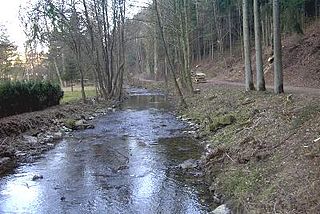
The Nims is a 61-kilometre-long (38 mi), lefthand arm of the River Prüm in the South Eifel region of the Eifel Mountains. It runs through the county of Bitburg-Prüm in the German state of Rhineland-Palatinate.

Waldeck Castle within the limits of the village of Dorweiler in Dommershausen in the Rhein-Hunsrück-Kreis (district) in Rhineland-Palatinate was the main seat of the Hunsrück family of Boos.
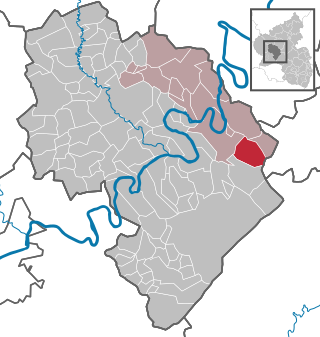
Irmenach is an Ortsgemeinde – a municipality belonging to a Verbandsgemeinde, a kind of collective municipality – in the Bernkastel-Wittlich district in Rhineland-Palatinate, Germany.
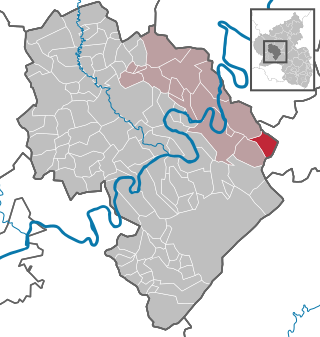
Lötzbeuren is an Ortsgemeinde – a municipality belonging to a Verbandsgemeinde, a kind of collective municipality – in the Bernkastel-Wittlich district in Rhineland-Palatinate, Germany.

Lindenschied is an Ortsgemeinde – a municipality belonging to a Verbandsgemeinde, a kind of collective municipality – in the Rhein-Hunsrück-Kreis (district) in Rhineland-Palatinate, Germany. It belongs to the Verbandsgemeinde of Kirchberg, whose seat is in the like-named town.
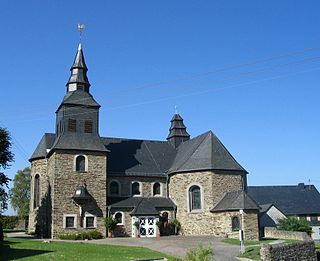
Lingerhahn is an Ortsgemeinde – a municipality belonging to a Verbandsgemeinde, a kind of collective municipality – in the Rhein-Hunsrück-Kreis (district) in Rhineland-Palatinate, Germany. It belongs to the Verbandsgemeinde Hunsrück-Mittelrhein, whose seat is in Emmelshausen.
Stephen I, Count of Sponheim is the patriarch of the Rhenish branch of the House of Sponheim, which ruled over the County of Sponheim. He was closely related to Siegfried I, Count of Sponheim, patriarch of the Carinthian Sponheimish branch, but the exact relationship between the two dynasts is disputed. Johannes Trithemius credits a Count Eberhard of Sponheim as founder of the Abbey of Sponheim and dates the founding to 1044, a position questioned by Johannes Mötsch. The Genealogia Sponhemica presents Count Eberhardus as son of Countess Hedwig and father of a single Count Stephenus I/II of Sponheim. Donald C. Jackman considers Stephen I a son of Siegfried I. Both Jackman and Josef Heinzelmann consider Stephen as being identical to Stephen, Vogt of Worms documented with his brother Markward in 1068. Heinzelmann however casts doubt on a male lineage relationship of Stephen and Siegfried and sees Stephen I of Sponheim as being Lord of Sponheim but not a Count, notices that Stephen I of Sponheim is documented in 1075 as "S(igna) Stepheni de Spanheim" with his seal in a document of Udo, Archbishop of Trier, and proposes Stephen to have married into the House of Sponheim. In another work Heinzelmann considers the Stephen mentioned in 1075 to be Stephen II, or maybe a single Stephen, mentions a Mainzer ministerialis Stephen, the son of Embricho (Emich) and nephew of Archbishop Ruthard, who lived later, as a possible relation, and puts forward that the documented Stephen and Markward belong to the House of the Counts of Metz/Lunéville, which later provided the Vogts of Worms:
"Identisch kann er sein mit einem Wormser Vogt Stephen (1068) [239 UB Stadt Worms I, Nr. 55], der mit seinem Bruder Markwart zu den Grafen von Lunéville/Metz zu gehören scheint, die mit den de Meti später die Wormser Vögte stellen."
Johannes Mötsch is a German archivist and historian.

The Eisbach, locally known as die Eis, is a 38-kilometre (24 mi) long river and left or western tributary of the Rhine in the northeastern Palatinate and southeastern Rhenish Hesse, in the German state of Rhineland-Palatinate.
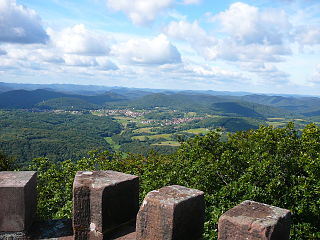
The Wasgau is a Franco-German hill range in the German state of Rhineland-Palatinate and the French departments of Bas-Rhin and Moselle. It is formed from the southern part of the Palatine Forest and the northern part of the Vosges mountains, and extends from the River Queich in the north over the French border to the Col de Saverne in the south.

The Westrich Plateau, also Zweibrücken Westrich or Southwest Palatine Plateau, is a landscape in the German state of Rhineland-Palatinate, with small areas also in the Saarland (Saarpfalz-Kreis). Its heart is in the southwest of the Palatinate region and it is part of the historic region of Westrich.

The Ahr valley is named after the Ahr, a left tributary of the Rhine in Germany. It begins at the Ahr spring (Ahrquelle) in Blankenheim in the county of Euskirchen and runs generally eastwards. At its southernmost point it enters the county of Ahrweiler, and hence the state of Rhineland-Palatinate. Running through the collective municipality of Adenau the valley bends northeast at its confluence with the Adenauer Bach and reaches the collective municipality of Altenahr, from where it resumes its characteristic west to east course, albeit interrupted by meanders. Here begins the section that is known as the Ahr valley (Ahrtal) in a touristic sense. Here it is characterized by vineyards on the south-facing slopes and a picturesque rocky landscape, carved out by the river creating a 300 metre deep gorge in the Ahr Hills. In the next stage the Ahr reaches the area of the county town of Bad Neuenahr-Ahrweiler, before finally discharging into the Rhine south of Remagen in the borough of Sinzig.

The Katharinenkirche in Oppenheim, Germany, is regarded as an important Gothic church building on the Rhine, along with the cathedrals of Cologne and Strasbourg. Construction began probably in 1225, when Oppenheim was granted Town privileges. Since the merger of the Lutheran and Reformed congregation in 1822, it is a United Protestant church and its congregation forms part of the Protestant Church in Hesse and Nassau. The church is a venue of church music too. Church musicians are the organists Ralf and Katrin Bibiella.

The Upper Germanic-Rhaetian Limes, or ORL, is a 550-kilometre-long section of the former external frontier of the Roman Empire between the rivers Rhine and Danube. It runs from Rheinbrohl to Eining on the Danube. The Upper Germanic-Rhaetian Limes is an archaeological site and, since 2005, a UNESCO World Heritage Site. Together with the Lower Germanic Limes it forms part of the Limes Germanicus.

The Eltz Feud was a 14th-century feud that arose between rulers of the Trier region on the Moselle and certain members of the knightly class who were acting independently and failing to support their sovereign princes. It came about as a result of attempts in 1331 by the Archbishop of Trier and Elector Baldwin of Luxembourg to re-incorporate the imperial ministeriales or knights of the castles of Ehrenburg, Eltz, Schöneck and Waldeck as vassals into the administrative district of Trier and to subordinate them to a unified, sovereign state administrative structure. Their distance from the power of the imperial government and a weak predecessor of Archbishop Baldwin had allowed the knights to acquire autonomy and rights supposedly under the law of custom, even though they were already vassals and fief holders of the Archbishop.
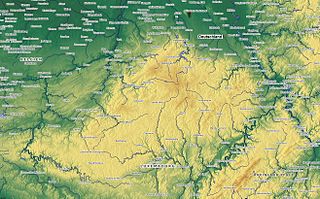
The Eifelgau was a Frankish gau in the region of the present day Limestone Eifel in Germany.

Stauf Castle is a ruined spur castle near the village of Stauf in the borough of Eisenberg in the county of Donnersbergkreis in the German state of Rhineland-Palatinate.

Marienstatt Abbey is a Cistercian monastery and a pilgrimage site in Streithausen, Westerwaldkreis, Rhineland-Palatinate, in the Nister valley near Hachenburg.
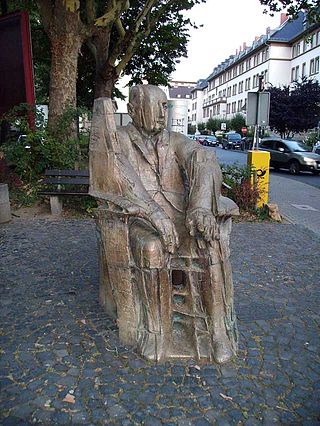
Fritz Michel was a German physician, politician, historian and art historian.

Mainz Charterhouse is a former Carthusian monastery, or charterhouse, in Mainz, Rheinland-Pfalz, Germany, demolished in 1790–1792 but still marked by the street-name "Karthaus".
References
- 1 2 3 Heinrich Beyer: Urkundenbuch zur Geschichte der, jetzt die preussischen Regierungsbezirke Coblenz und Trier bildenden mittelrheinischen Territorien, Vol. 2, Coblenz: Hölscher, 1865, page XVIII (dilibri Rheinland-Pfalz)
- 1 2 Johann Friedrich Schannat: Eiflia illustrata oder geographische und historische Beschreibung der Eifel, Vol. 1, 1824, pp. 131 ff (Google Books)
- ↑ Werner Bornheim: Zur älteren Geschichte der Grafen von Ahre in "Archiv für mittelrheinische Kirchengeschichte", Gesellschaft für Mittelrheinische Kirchengeschichte, 1954, p. 130 (dilibri Rheinland-Pfalz)